Own well on the site allows you to use running water without any restrictions - no you need to choose a specific time to wash, take a bath, wash your car or water the flower beds near at home. Agree, it's great when water always flows from the tap without interruptions and there is no schedule for supply / unscheduled shutdowns.
Water supply problems can arise if the pump breaks down. Knowing how to disassemble a submersible pump, you can independently identify malfunctions and fix them at home. We will talk about how to correctly diagnose a breakdown in this material. We will also consider in detail the instructions for disassembling the pump with our own hands, providing the article with step-by-step photos and useful video recommendations.
The content of the article:
- Why does the equipment break down?
-
Troubleshooting overview and troubleshooting tips
- Problem # 1 - the pump is not working
- Problem # 2 - pressure drops
- Problem # 3 - impulse water delivery, noise and vibration
- Problem # 4 - overconsumption of electricity
- Problem # 5 - constantly knocking out plugs
- Problem # 6 - the pump is humming but not pumping
-
Detailed pump disassembly instructions
- Subtleties of disassembling the pump section shaft
- Step-by-step process of disassembling an electric motor
- Typical breakdowns of pumps of different brands
- Conclusions and useful video on the topic
Why does the equipment break down?
The submersible borehole pump provides the convenience and ease of use of the well. It lifts water from a great depth to the surface, where it flows through communications to the points of water intake.
Produce household submersible pumps domestic and foreign enterprises. And although the pumping equipment is reliable, breakdowns may occur from time to time during operation.

All elements of submersible pumps are precisely fitted and easily disassembled. If during the assembly process the parts do not fall into place freely, then the order of installation of individual components is violated.
The debugged and precise operation of a submersible pump is often violated by the following reasons:
- high (more than 50%) concentration of suspended particles in water;
- dry operation, when the device operates without touching the water;
- voltage drops above the permissible level that regularly occur in the network;
- poorly secured cable connections;
- unit cable not correctly attached in the area of the borehole head;
- the submarine cable is not properly fixed.
The absence of a filter or its too heavy contamination, unstable operation provoke the occurrence of malfunctions pressure switch or poorly functioning hydroaccumulator.
In the absence of grounding, electrochemical corrosion affects the metal elements of the equipment. The pump stops pumping water normally and requires immediate service.
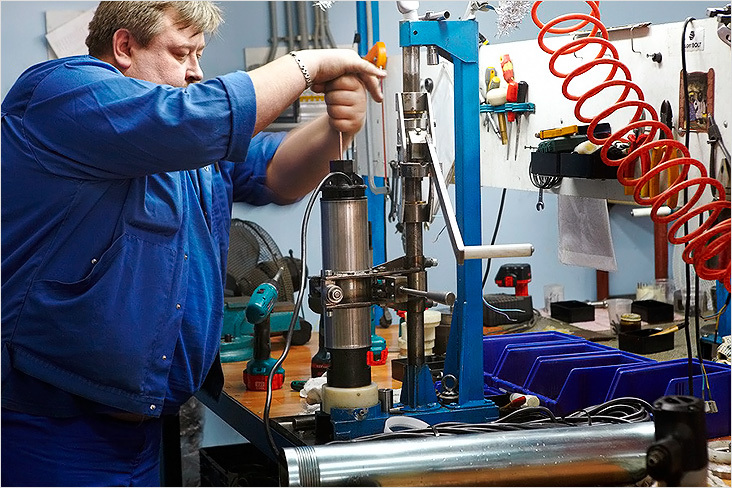
If problems arise with a new pump that is under warranty, you should not fix them yourself. It is better to take the device to a company service. There, professional masters with experience will restore its working capacity.
Very often errors made by users in the process are the cause of a malfunction. pump installation and its operation. Manufacturers and employees of service centers recommend that buyers, immediately before connecting the devices, carefully read the instructions and strictly follow everything that is written there. This will avoid many problems and extend the life of the pumping equipment.
Troubleshooting overview and troubleshooting tips
Any changes in the operation of submersible instruments clearly indicate problems and malfunctions. Such moments cannot be ignored. Timely repairs extend the life of the device and ensure its normal operation in a convenient mode for the owners.
It is necessary to think about servicing the pumping unit if the following points are found:
- a pronounced decrease in water pressure;
- increased noise from the well;
- intense vibration of the casing;
- impulse flow of water from the tap;
- increased power consumption;
- knocking out plugs when the unit is activated;
- humming of the engine on when there is no pumping.
In this case, it is necessary to remove the submersible device from the well using a safety cable, disassemble, identify the area of problems and eliminate them.
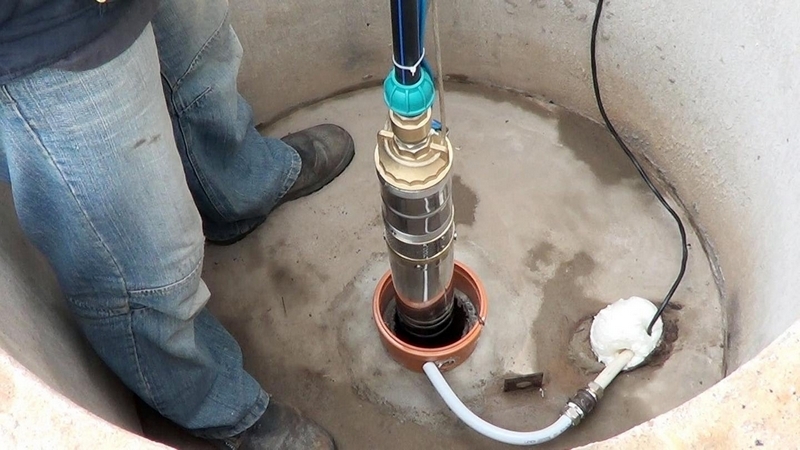
When removing the pump from the well, proceed carefully. Damaged or warped parts of the casing, silt deposits or limescale formed on the walls can interfere with the process if water is taken from artesian strata
Moreover, the same malfunction is eliminated in different ways for different types of pumping equipment.
So, depending on the design features and the principle of operation, submersible pumps can be:
- centrifugal - they have the main element of the impeller ("Aquarius", "Vodomet");
- vortex - they are similar to centrifugal ones, but they have a high circular velocity of the liquid ("Vortex");
- vibrating - for vibrators, the main element is the piston ("Kid").
Before moving on to the popular breakdowns of pumps, we suggest that you once again remember their device.

The diagram shows the main structural elements of a submersible electric pump of a centrifugal type. Knowledge of the equipment design will help identify the cause of the malfunction.
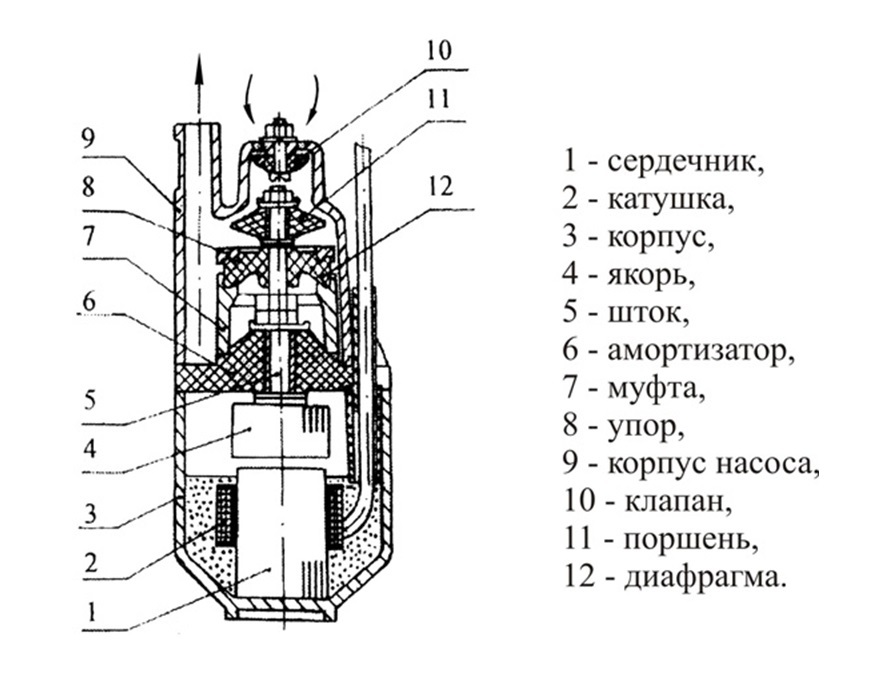
Knowledge of the device of a vibration-type submersible pump will help diagnose breakdowns and repair the corresponding structural element of the electric pump
Next, we will consider a list of frequent breakdowns of vibration and centrifugal submersible pumps, as well as recommendations for their elimination at home.
Problem # 1 - the pump is not working
If the device does not function, the electrical protection may have tripped. It is necessary to disconnect the device from the power supply, and then turn on the automatic plug again. Then you need to connect the electric pump to the network.
If the phase is knocked out again, the problem should not be looked for in submersible equipment, but carefully inspect the cable and fuses. In this situation, it is better not to connect the device to the network until the circumstances of the malfunction are clarified.
Blown fuses must be replaced immediately. If they burn out again, the reason is pump power cable or in the area of its connection to the electrical network. All these elements should be checked and any damage found should be repaired. Only after full service can the pump be used again.
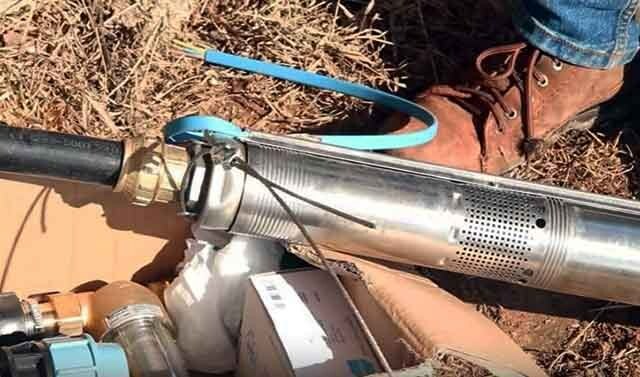
If the submarine cable is damaged, the pump will not pump liquid. To restore the device to work, it is necessary to remove it from the well, restore the integrity of the cable, put it back in and connect to the network
Problem # 2 - pressure drops
A significantly reduced level of water pressure in centrifugal models clearly indicates excessive impeller wear, silting or at its displacement along the shaft. Also, this situation provokes clogged mechanical filterlocated on the suction port.
The solution in this situation is to thoroughly check the impeller, clean the impeller and filter, and replace the worn impeller.
A noticeable weakening of the pressure of the vibrators is caused by the suction valve that has ceased to close or a deposit of silt and sand that has appeared on it. The same problem occurs when the vibration mechanism piston loses its elasticity. Also, the reason may be the weakening of the fastening of the piston, shock absorber or electromagnet. All these nuances are eliminated at home without much effort - just tighten the fasteners or replace the valve.
Or, the reason for the drop in pressure in vibration and centrifugal pumps can be even simpler - low voltage in the network. In this case, it will not hurt to install a stabilizer.
Problem # 3 - impulse water delivery, noise and vibration
Increased noise from the well indicates shaft breakage or loosening the nutsfixing the position of the rod on the shock absorber in the vibration pump. In the first case, the shaft needs to be changed to a new one, in the second - to tighten the loose fasteners with an improvised tool.
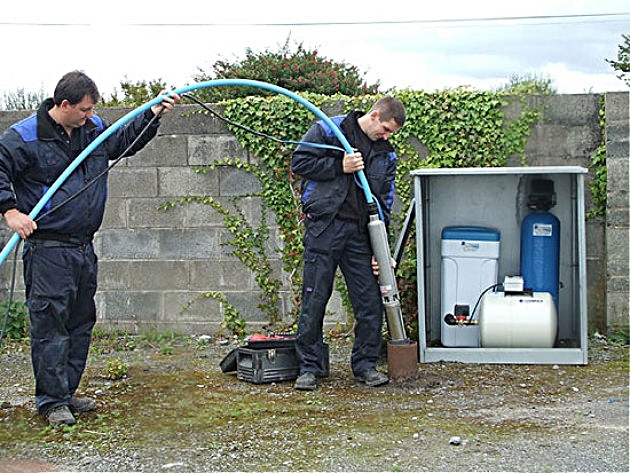
An intermittent, whistling jet in the tap indicates that the water level in the well has dropped below the dynamic one, and the filter element on the suction pipe is exposed. The situation can be corrected by simply lowering the pump to a greater depth. If the distance to the bottom of the mine provides such an opportunity
If the pump begins to vibrate strongly and this is reflected in the casing, it may be out of order. shaft or stock. The equipment should be removed, disassembled and damaged parts repaired. In case of fatal breakdowns, replace with new ones.
Problem # 4 - overconsumption of electricity
If you notice an unexpected increase in your electricity bills, you should pay close attention to your submersible equipment. You may need balancing of impellers submersible centrifugal electric pump.
Either silt or sand got into the hull and caused mechanical friction. The load increased and the unit began to consume more electricity to pump a standard volume of water.
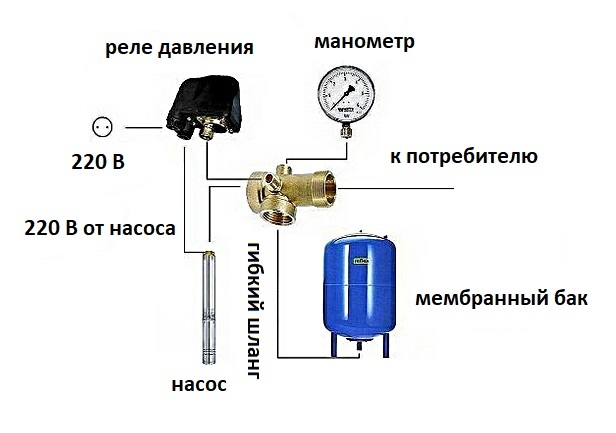
The pump will not be able to shut down if the pressure switch is incorrectly adjusted or fails. Installing a new part will quickly deal with the problem
Increased consumption could be provoked by worn out screw cavity and bushings on the shaft of the screw unit. They must be replaced with new ones as soon as possible and the pump will return to work in the same mode.
Problem # 5 - constantly knocking out plugs
Always triggered protection when the submersible vibration pump is turned on (knocking out plugs) - the result violationsbody tightness engine compartment. Moisture trapped inside has a negative effect on the control electronics and interferes with normal operation. The result is often a short circuit, which is followed by additional problems, up to the burning of equipment.
Also, the cause of knocking out plugs can be an open / short circuit in the cable or electromagnet coil, overheating of the electromagnet due to low voltage in the mains, or false triggering of plugs. In this situation, it is necessary to replace the cable or coil (depending on where the malfunction is detected), check the plugs and replace them if necessary, install the stabilizer.
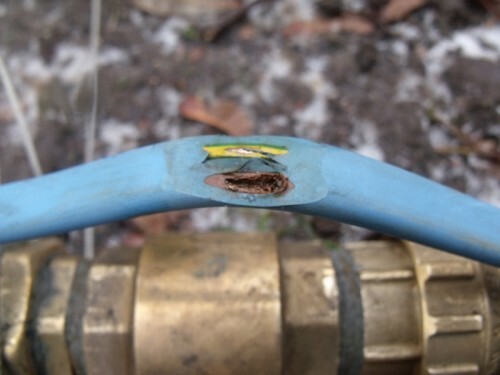
If the insulation of the supply cable is broken for some reason (breakdown), the protection will definitely work. After restoring the integrity of the bed, the pump will return to normal operation.
The protection of centrifugal pumps is triggered by a short circuit stator winding or anchors electric motor and jamming the device with various particles of debris. To fix the problem, you will need to clean the unit from possible blockages, take it for rewinding to a service center, or install a new coil.
Problem # 6 - the pump is humming but not pumping
When a submersible pump hums loudly, but does not pump water from the well into the communication system, there may be several reasons at once. May be, mains voltage dropped and the equipment simply does not have enough power to start normally. If the voltage drop is typical for your region, it makes sense to play it safe and install stabilizer.
Other possible causes for centrifugal models: wear or clogging of the impeller, loosening fastening the impeller to the shaft, clogging of the coarse filter, breakage of the key connecting the impeller to shaft. Also, if the pump has been kept out of water for a long time, the impeller may "stick" to the casing. Or, dirt accumulates in the case and the device gets jammed.
To eliminate these breakdowns, it is necessary to clean all the contaminated elements, replace the faulty ones with new ones, and tighten the fasteners.
The same problem with the hum of the electric pump-vibrator can arise due to: wear of the valve or piston, displacement of the electromagnet, crushing of the shock absorber and loosening of its fastening. Repair work in this case will consist in replacing worn parts, tightening the fasteners, installing the electromagnet and shock absorber in place and their reliable fixation.
To troubleshoot, the equipment will have to be removed from the well, carefully inspected and repaired.
Detailed pump disassembly instructions
To identify and troubleshoot a submersible pump, it must be disassembled into its constituent elements. To do this, you will need a spacious workplace and a stable wide table, a vice, a Phillips and flat screwdrivers, a set of keys and pliers.
The disassembly process is not complicated, but it requires precision, scrupulousness and attention.
It is carried out in stages in a specific order.
Image gallery
Photo from
Using an ordinary screwdriver, unscrew the screws securing the mesh of the device. Take it off and put it aside
Try to crank the motor shaft by hand. If this fails, then the problem should be looked for in the pumping part of the unit or in the electric motor.
To get to the pump section, it is necessary to unscrew all the screws on which the power cable is attached and carefully disconnect it from the device body.
Unscrew the 4 anodized nuts holding the pump flange. Separate the pumping part from the electric motor
Step 1 - Unscrewing the screws holding the mesh
Step 2 - Manually Cranking the Motor Shaft
Step 3 - removing the screws holding the power cable
Step 4 - Removing the Flange Retaining Nuts
When the pump section and engine compartment are separated from each other, troubleshooting is much easier and more convenient.
Subtleties of disassembling the pump section shaft
To determine the exact location of the problem, try to rotate the shaft of the pump section. If this is not possible, then the problem is there.
Image gallery
Photo from
To disassemble the unit, unscrew all fasteners fixing the lower flange of the pump section of the module
To protect the threads from potential damage, screw the adapter into the upper union of the block.
Place an iron vise on the desktop and firmly fix the pumping part in them
Loosen the bottom flange with a suitable tool, then remove and lay to one side.
Pull the impeller unit out of the housing and carefully inspect for possible malfunctions
Carefully check the condition of the support shaft. Find out if there is any backlash. Determine the wear level of the part
Always replace damaged or worn impellers. To do this, firmly fix the shaft in a vice and unscrew the upper nut
Remove the blocks with working elements, rinse in running water, if any contamination is found. If parts are too worn out or have changed shape, replace with new ones
Step 1 - Unscrewing the bottom flange fasteners
Step 2 - Installing the Thread Protection Adapter
Step 3 - Securing the Pump in a Vise on the Table
Step 4 - Removing the Pump Bottom Flange
Step 5 - Removing the impeller block from the housing
Step 6 - Inspecting for wear and play
Step 7 - Unscrewing the retaining nut from the impeller block
Step 8 - cleaning the elements of the vane block
At the end of the activities related to the repair / replacement / maintenance of the pumping part, reassemble the equipment, carefully following the instructions. Then connect to the engine and return to the workplace.
Step-by-step process of disassembling an electric motor
If at the two stages described above it was not possible to identify the area of the problem, there is a great chance that it lies in the engine. To finally make sure of this, you need to do the following important steps.
Image gallery
Photo from
Fix the motor disconnected from the pumping part in a vise. Remove the fasteners and carefully remove the plastic flange protection
Take the pliers and remove the retaining ring holding the cover. Using a flat screwdriver, pry off the cover and remove
Carefully remove the elastic rubber membrane from the casing of the pumping equipment
Pull out the capacitor. Correctly diagnose the equipment and check the oil level. Determine the cause of the jam and eliminate it
Step 1 - Dismantling the submersible pump motor
Step 2 - Removing the Retaining Ring and Cover
Step 3 - Removing the rubber membrane from the body
Step 4 - Removing the condenser from the submersible pump
Assemble the engine block following the prompts in the instructions. Make sure that all parts are in their original places.
Typical breakdowns of pumps of different brands
Equipment of popular domestic and foreign brands has its own characteristic breakdowns. Devices from a Danish manufacturer Grundfos, despite the reliability and endurance, need regular replacement of mechanical seals. If this is not done in a timely manner, water will penetrate inside and damage the winding.
It is not advisable to service the unit at home. The specific design requires that the repairs be carried out by a specialist with experience, ideally an employee of the company's service center.
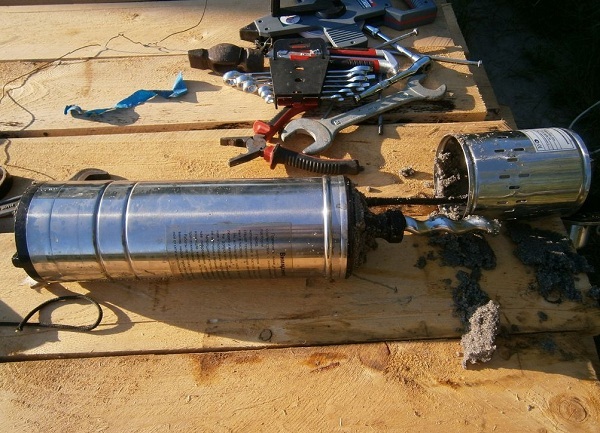
A pronounced hum and a drop to a minimum head indicate that the impeller has worn out or has shifted along the axis of the pump. The device must be disassembled, cleaned of sand, replace damaged elements and install new seals
Aggregates Gilex often fluid leaks out of the electric motor. Replacing it is possible, but only with a similar composition.
Some masters believe that it is not necessary to buy an expensive substance. You can get by with glycerin or transformer oil. However, this is not the best advice. The technique does not tolerate filling with alternative means very badly and can completely fail after such an operation.
It is better not to repair the device yourself, but to entrust this task to qualified specialists. They are guaranteed to pour the original composition into the engine and do it in strict accordance with the manufacturer's wishes. After service, it will work as well as on the first day of purchase.
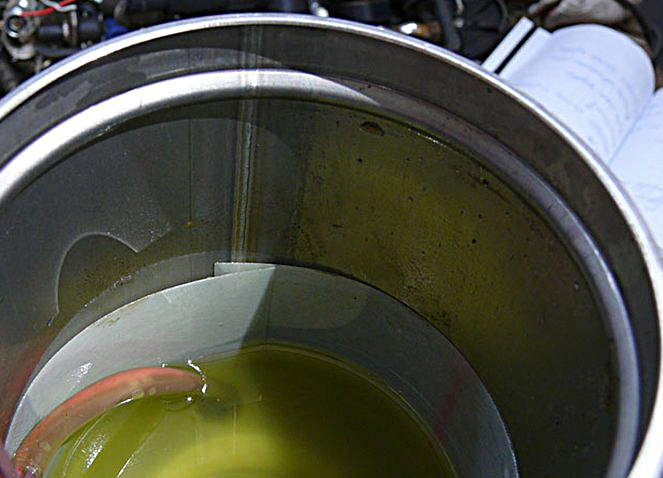
Wear of the oil seals is indicated by a low oil level in the pump engine. It is best to replace them as soon as possible. This will keep the motor from overheating.
In devices "Baby" Russian enterprises Livgidromash often fail coils. This nuisance is provoked by dry work. A loud noise when turned on without pumping water indicates break of the central axis, to which the membranes with an anchor are attached. This breakdown is easy to spot after disassembling the unit.
Replacing the axle, even at home, is not difficult. But finding a part on sale is really a problem.
Pumps "Aquarius" have the property overheatI am. This drawback is especially active when the equipment is operating in shallow wells. Renovation is expensive and sometimes amounts to about 50% of the original cost. In such cases, many users prefer to buy a new device, albeit from another manufacturer.
The same problem is typical for models "Stream". Despite the modern design and compliance with the current European standards, they poorly tolerated continuous operation.
The manufacturer says that the devices can continuously pump water for no longer than 7 hours. However, this load almost always leads to overheating. To avoid problems, it is best to take breaks and let the equipment rest every 2-3 hours. In this way, the service life of the pump can be extended.
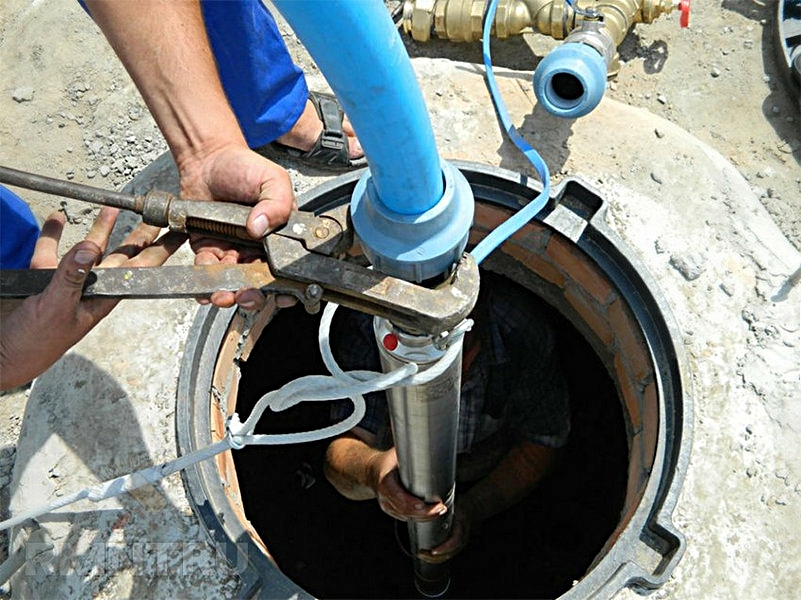
Do not start devices for pumping water with the shut-off valve closed. In the future, this will lead to damage to the pumping equipment. Before turning on the valve, be sure to open
Pump equipment "Vodomet" considered to be sufficiently reliable and operationally stable. Most of the breakdowns here are due to misuse. Also, when in contact with contaminated water, equipment quickly becomes clogged with silt and sand. In this case, the pumping part of the unit must be replaced.
When a problem that has arisen cannot be solved at home, you should seek help from professional craftsmen of a certified service center. They will quickly determine what happened to the equipment and restore it to working order. Or they will recommend purchasing and put a new pumpif the old one cannot be repaired or it is not economically viable.
Conclusions and useful video on the topic
This video describes the process of disassembling a submersible pump. How to do everything right and what tools are required for this, see below:
The pump is clogged with sand and does not pump water. The following video will tell you how to cope with one of the most common problems of pumping equipment:
The pump in the well turns on, hums, but does not pump water. The two most common causes of this problem are discussed in the video below:
Knowledge of the rules for disassembling submersible pumping equipment will certainly come in handy for owners of private houses with wells. Focusing on popular pump malfunctions, you can recognize the type of breakdown and fix it with your own hands. This is convenient when the service is far away, and the pump, for certain reasons, works intermittently and does not allow comfortable use of water.
Have you encountered a pump breakdown that we did not mention in this article and want to share your experience in repairing it? Tell us about it in the comments block, add photos demonstrating the process of fixing the breakdown - our readers will be grateful for your help.
Or do you need help diagnosing a problem? Ask your questions to our experts - use the feedback form below.


